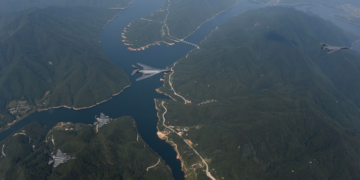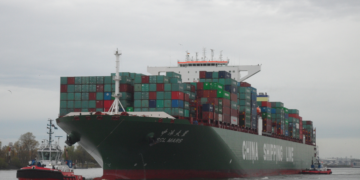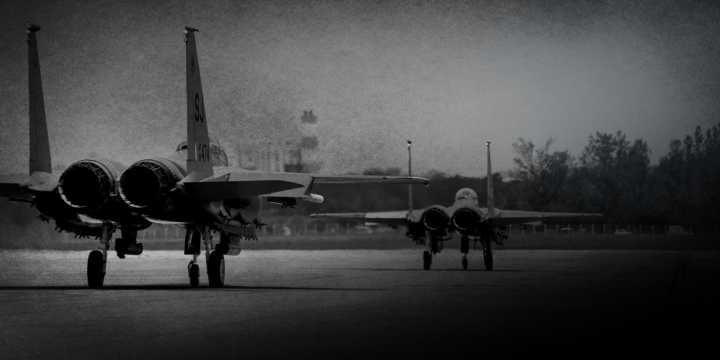April 5, 2022
Raising the minimum: explaining China’s nuclear buildup
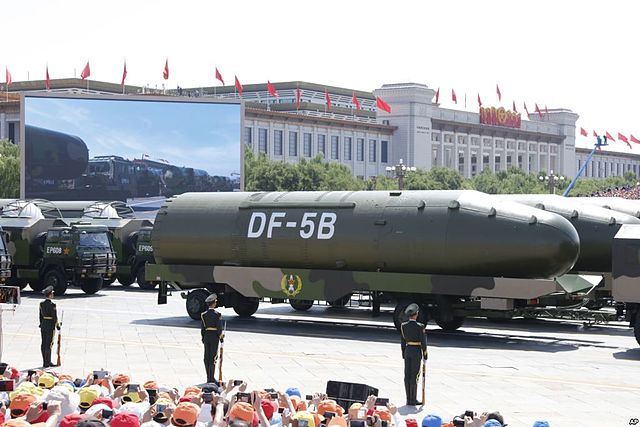
Key points
- China’s nuclear buildup, consisting of new ICBMs, submarine-launched weapons, a new generation of strategic bombers, and advances in hypersonic weapons, implies a significant recalibration of Beijing’s traditional “minimum deterrence” strategy.
- Beijing deliberated for decades about whether to increase its nuclear arsenal, and it finally seems to be doing so, at least partially in response to the precipitous decline in U.S.-China relations, U.S. initiatives to develop ballistic missile defense, and U.S. nuclear doctrine.
- China is not bidding for numerical nuclear superiority against the United States with its buildup. Rather, China is likely looking to secure its “second strike” deterrence forces and negate any perception of U.S. nuclear predominance to avoid being coerced by the United States, especially with respect to Taiwan. China’s buildup reflects a strengthening of its deterrent and thus does not contradict China’s long-time policy of “no first use” (NFU). Beijing wants decision-makers in Washington to recognize its credible deterrent.
- The United States should both preserve strong nuclear deterrent forces and avoid an overreaction to China’s buildup. U.S. nuclear modernization should focus on survivability and be accompanied by attempts at dialogue, arms control, and the development of crisis management mechanisms.
“Sputnik” redux?
The November 2021 estimate by the Department of Defense (DoD) that China could triple its nuclear warheads stockpile by 2030 to 1,000 set off alarms in Washington.1Idrees Ali and Phil Stewart, “Pentagon Sharply Raises Its Estimate of Chinese Nuclear Warheads,” Reuters, November 4, 2021, https://www.reuters.com/world/pentagon-sharply-raises-its-estimate-chinese-nuclear-warheads-2021-11-03/. This new estimate, coupled with a Chinese hypersonic glide vehicle test, prompted the Chairman of the Joint Chiefs of Staff (JCS) Gen. Mark Milley to claim Americans were witnessing another “Sputnik moment.” Vice Chairman of the JCS and former STRATCOM Commander Gen. John Hyten commented that “the pace at which China is moving is stunning.”2Robert Burns, “Pentagon Rattled by Chinese Military Push on All Fronts,” Associated Press, November 1, 2021, https://apnews.com/article/technology-china-asia-united-states-beijing-aea288656fab23253ee0397dc21ba68a.
Yet such dramatic appraisals are misleading since they fail to acknowledge the United States has, and will continue to have, far more nuclear weapons than China. Likewise, they neglect the fundamental conclusion that this seeming nuclear advantage stands as an expensive, but worthless, luxury since Washington and Beijing are already situated in circumstances of mutual vulnerability (both nations can inflict devastating punishment via nuclear strikes on the other). Finally, U.S. military appraisals also miss the mark in declining to discuss the wider context of China’s buildup. Given the historically small number of China’s nuclear forces, paired against a variety of moves in U.S. strategy viewed by Beijing as provocative—including the dynamic development of both tactical nuclear weapons and missile defenses—it is surprising China has not moved faster to redress this rather stark asymmetry in the strategic military balance.
Nuclear weapons have long been regarded by strategists as a game-changing weapon and a pivotal support to the “long peace” that has prevailed among the great powers since 1945. These weapons are so devastating in their impact that they cause leaders to behave more cautiously.3Robert Jervis, The Meaning of the Nuclear Revolution: Statecraft and the Prospect for Armageddon (Ithaca, New York: Cornell University Press, 1990). Such caution is thankfully quite evident in the current crisis with Russia in early 2022.4Phil Stewart and Idrees Ali, “U.S. Delays ICBM Test-launch in Bid to De-escalate Russia Nuclear Tensions,” Reuters, March 2, 2022, https://www.reuters.com/world/us/us-delays-icbm-test-launch-bid-de-escalate-russia-nuclear-tensions-2022-03-02/. Nuclear arsenals are most stabilizing when countries interact within conditions of mutual assured destruction (MAD). This circumstance gives both sides strong reasons to avoid direct conflict and escalation to nuclear use. An essential nuance is that smaller or less developed arsenals could create first-strike incentives—the logic being that a country could conceivably try to destroy the opponent’s entire arsenal in one devastating blow. American leaders seriously considered such options in the early Cold War.5Fred Kaplan, “JFK’s First Strike Plan,” Atlantic, October 2008, https://www.theatlantic.com/magazine/archive/2001/10/jfks-first-strike-plan/376432/. Recognizing this problem, all nuclear states have moved to increase the survivability of their respective nuclear systems, thus moving toward fielding so-called “second strike” nuclear forces. The intention is that these forces are so robust and well-hidden that they could absorb a first strike by an adversary and make a second strike—thus assuring deterrence with the threat of a guaranteed retaliatory blow. Missile defenses, if they work, could reduce the odds of second-strike success, undermining the stability provided by MAD.
Some countries, and China in particular, chose to adopt a declaratory policy of “no first use” (NFU). Washington has been cautious about adopting such a policy on the logic that it could dampen deterrence.6Ankit Panda and Vipin Narang, “Sole Purpose is Not No First Use: Nuclear Weapons and Declaratory Policy,” War on the Rocks, Feb 21, 2021, https://warontherocks.com/2021/02/sole-purpose-is-not-no-first-use-nuclear-weapons-and-declaratory-policy/. Because the United States has so many allies—because it extends deterrence, in nuclear parlance—it avoids a NFU option, preferring to threaten to meet conventional aggression with a nuclear first strike, an approach reaffirmed in the March 2022 Nuclear Posture Review.7Tara Copp, “Biden’s Nuke Review Omits ‘No First Use’, Kills Naval Cruise Missile,” Defense One, March 30, 2022, https://www.defenseone.com/policy/2022/03/bidens-nuke-review-omits-no-first-use-kills-naval-cruise-missile/363823/. Since this is only credible if the strike can be seen as likely to disarm enemy nuclear weapons—such that is unnecessary to trade New York for Berlin or Istanbul or Seoul—the United States maintains a large and increasingly accurate arsenal designed so an adversary would at least have to consider a U.S. first-strike against its nuclear forces as a live possibility.8Austin Long, “Deterrence from Cold War to Long War: Lessons from Six Decades of RAND Research,” RAND Corporation, 2008, https://www.rand.org/content/dam/rand/pubs/monographs/2008/RAND_MG636.pdf.
U.S. nuclear forces in 2022 remain at 3,708 stockpiled warheads with another 1,750 awaiting dismantlement.9Matt Korda and Hans Kristensen, “Nuclear Notebook: US Nuclear Forces in 2021,” Bulletin of the Atomic Scientists, January 12, 2021, https://thebulletin.org/premium/2021-01/nuclear-notebook-united-states-nuclear-weapons-2021/. If this number remains static and China builds up from the current 350 warheads to 1,000 by 2030, as projected by the Pentagon, the ratio of America’s lead will decrease from roughly 11:1 to 4:1.10Matt Korda and Hans Kristensen, “Nuclear Notebook: Chinese Nuclear Forces in 2021,” Bulletin of the Atomic Scientists, November 15, 2021, https://thebulletin.org/premium/2021-11/nuclear-notebook-chinese-nuclear-forces-2021/. However, these ratios are deceptive when it comes to the ultimate weapon, since only a very small number of deliverable weapons are needed for adequate deterrence—the remaining excess would simply cause “the rubble to bounce.”
China and U.S nuclear stockpiles
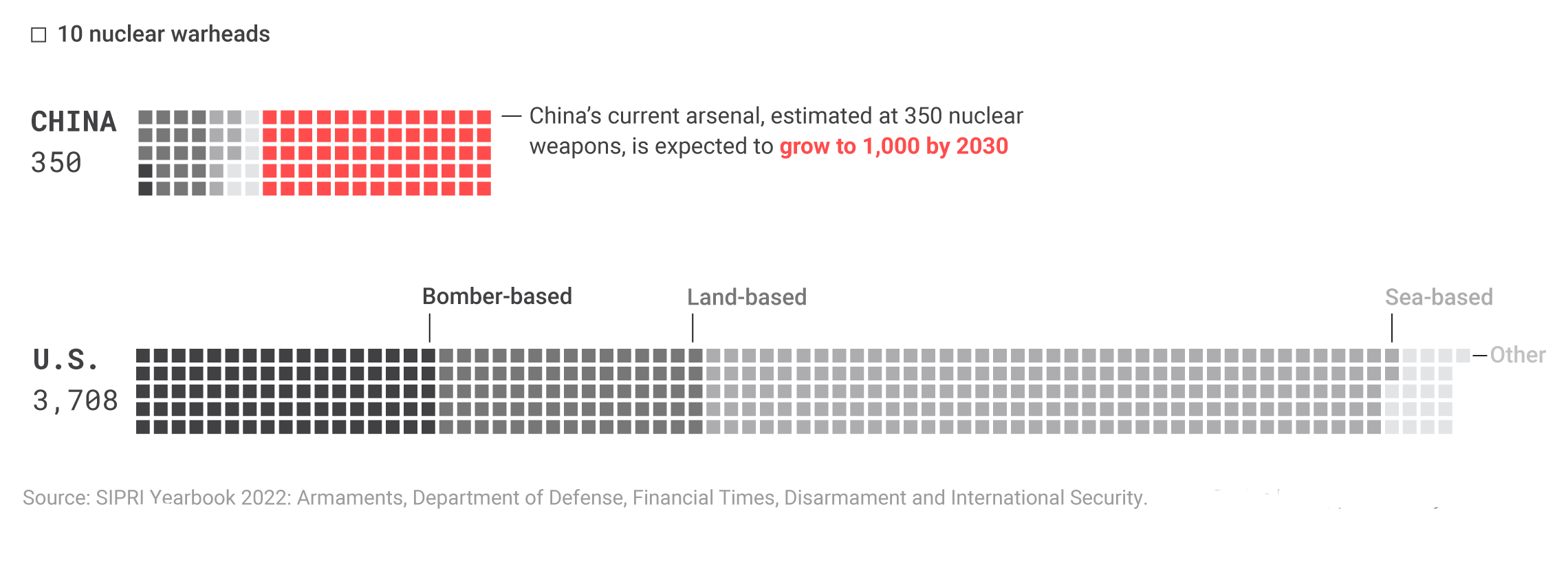
China’s nuclear stockpile, expected to reach approximately 1,000 nuclear weapons by the end of the decade, will grow more formidable in the coming years, but it will not fundamentally alter the balance of power as the United States will maintain its large qualitative and quantitative advantage in nuclear weapons.
Perceived instability in the nuclear balance with Russia and China results not from a nuclear buildup by either Moscow or Beijing, though both are clearly modernizing, but because of the logic of extended deterrence. U.S. pledges to defend allies rely on the threat of nuclear attack on adversaries in the event they conventionally attack U.S. allies. But if the enemy can assuredly retaliate with nuclear weapons, how can this be credible? The perennial question of whether the United States would sacrifice Los Angeles for Taipei or Berlin continues to raise doubts about whether it can credibly assume these grave risks on behalf of others.
A recent analysis of China’s strategic challenge applies this Cold War logic to present circumstances: “If the United States launched a large-scale nuclear first strike, the Soviet Union would [have been] able to do the gravest damage to the United States in retort. Courting such a response was no longer credible, let alone sensible as U.S. interests in Western Europe, while important, could not match the importance of avoiding devastation of the American homeland.”11Elbridge Colby, The Strategy of Denial: American Defense in an Age of Great Power Conflict (New Haven, CT: Yale University Press, 2021), 232. The analysis concludes, “The basic strategic problem in later Cold War Europe is strikingly similar to what the United States faces with China today.”12Colby, The Strategy of Denial: American Defense in an Age of Great Power Conflict, 232.
The origins of China’s buildup lie in Beijing’s desire to maintain the ability to take Taiwan and its fears that U.S. planners think the threat of a nuclear first strike is useful in defending Taiwan. Chinese leaders seem to have assessed that—to make sure the U.S. nuclear capability does not blackmail them out of taking Taiwan—their minimum deterrent needs to be big enough to impress even the most hawkish elements in the U.S. national security establishment.
This analysis means Americans should not be overly alarmed by China’s moves in the nuclear domain. China is not newly hostile—it is newly conscious that a larger arsenal serves its long-standing designs on Taiwan. Confronted by what it sees as U.S. hostility, together with America’s massive nuclear arsenal, Beijing is taking steps to close its nuclear gap. Counterintuitively, China’s buildup may pave the way for a more stable global nuclear order by ensuring that caution prevails in all the relevant capitals concerning both international conflict generally and nuclear use particularly.
Global nuclear warhead totals
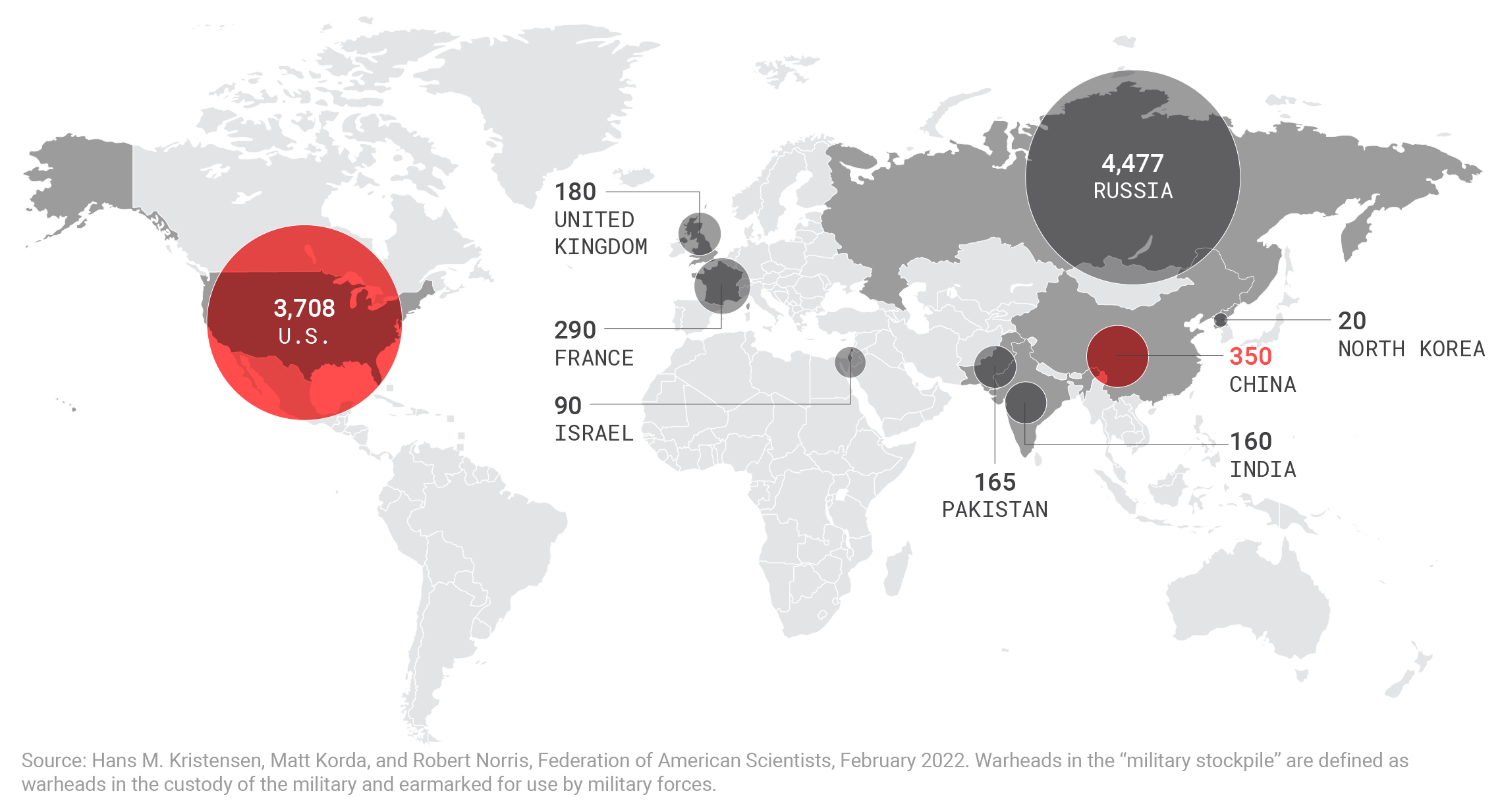
China’s nuclear arsenal is about one-eleventh the size of the United States’; however, Beijing is making moves to narrow the gap. DoD estimates China’s stockpile by 2030 will grow to 1,000, one-fourth the size of the U.S. arsenal.
Outlines of China’s nuclear buildup
Nuclear-tipped ICBMs
During the summer of 2021, China’s nuclear forces made headlines after U.S. arms control experts revealed three major ICBM fields were under construction in the Chinese provinces of Gansu, Xinjiang, and Inner Mongolia. This was the first independent confirmation of warnings from DoD in recent years. As two non-governmental experts explained in July 2021 regarding a newly detected field in eastern Xinjiang: “dome shelters have been erected over at least 14 silos and soil cleared in preparation for construction of another 19 silos.”13Matt Korda and Hans Kristensen, “China is Building a Second Nuclear Missile Silo Field,” Federation of American Scientists, July 26, 2021, https://fas.org/blogs/security/2021/07/china-is-building-a-second-nuclear-missile-silo-field/. They go on to place the new developments in a startling context: “[China appears] to have approximately 250 silos under construction—more than ten times the number of ICBM silos in operation today. The number of new Chinese silos under construction exceeds the number of silo-based ICBMs operated by Russia and constitutes more than half of the size of the entire US ICBM force.”14Matt Korda and Hans Kristensen, “China is Building a Second Nuclear Missile Silo Field.” DoD projected in its 2021 report on Chinese military power that Beijing could have 1,000 nuclear warheads by the year 2030. However, the United States retains a much larger force of 5,550 warheads, even if most of those are in reserve status.
China nuclear weapons silos
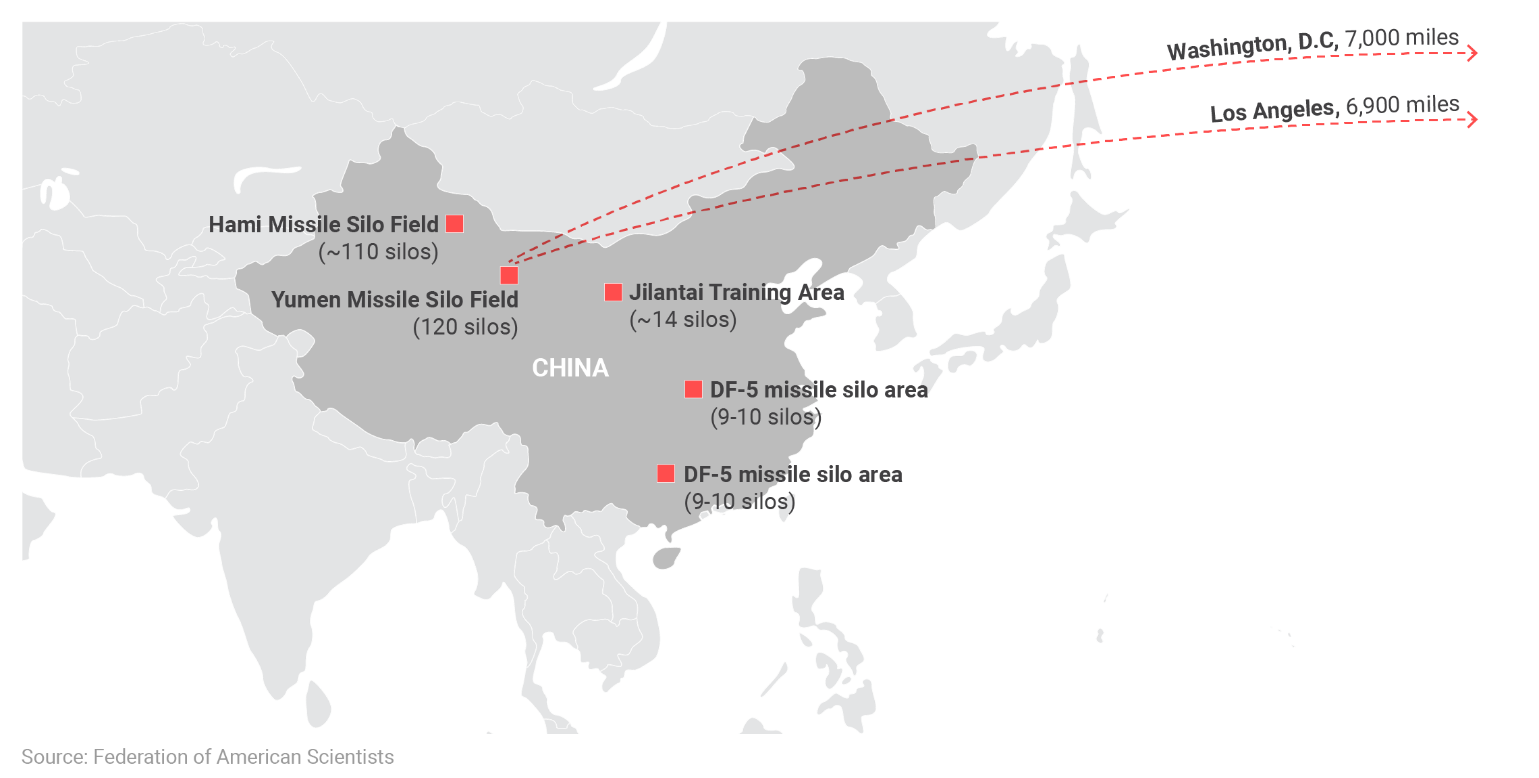
China’s growing nuclear missile silo fields mark a significant expansion in its nuclear arsenal, but it does not alter the balance of power, which favors the United States.
China’s evident focus on silos befuddled nuclear strategists, who have long argued that land-based silos are the least survivable, and thus most destabilizing, of all deployed nuclear weapons. Chinese military researchers have examined the contours of the U.S. land-based ICBM program, noting these systems have purported benefits, including precision, short launch times, simple command and control, and the prospect of economizing on costs.15Wang Ruichen, Li Jianlin, Liu Bingjie and Yang Haibo [王瑞臣,李建林,刘丙杰,杨海波], “Deployment and Development of USA Land-based Strategic Nuclear Force” [美国陆基战略核力量部署及发展], Ship Electronic Engineering [舰船电子工程] 41, no. 1: 3. It is worth noting the authors are identified as working at China’s Navy Submarine Academy in Qingdao. The Chinese assessment on the precision benefits of land-based systems may no longer be accurate when compared to American sea-based systems. Underlining the destabilizing nature of this buildup, Secretary of the Air Force Frank Kendall remarked, “If they continue down the path that they seem to be on—to substantially increase their ICBM force—they will have a de facto first-strike capability.”16Marcus Weiserber, “Air Force Secretary Warns of China’s Burgeoning Nuclear Arsenal, Reveals B-21 Detail,” Defense One, September 20, 2021, https://www.defenseone.com/threats/2021/09/air-force-secretary-warns-chinas-burgeoning-nuclear-arsenal-reveals-b-21-detail/185486/. That is a gross exaggeration—China will still be nowhere near a first-strike capability against the United States with this buildup and has no real prospect of changing that given the invulnerability of the U.S. ballistic missile submarine force. But this statement is emblematic of official concern regarding China’s current nuclear buildup and shows the importance of dispelling it.
It is worth noting the main backbone of China’s nuclear forces for over a decade has been truck-mounted, mobile ICBMs, including the DF-31, DF-41, and DF-26 missiles. Each of these systems has its own unique attributes. The DF-26 has been described as a dual-capable system that could carry either conventional or nuclear payloads.17Lyle Goldstein, “How Many Americans Would Die in a Nuclear War with China?” National Interest, October 21, 2021, https://nationalinterest.org/blog/reboot/how-many-americans-would-die-nuclear-war-china-194806. A Chinese analysis of the DF-41 mobile ICBM suggests the missile carries multiple independent reentry vehicles (MIRVs) and could strike any target in the continental United States except Florida.18Lyle Goldstein, “How Many Americans Would Die in a Nuclear War with China?” Moreover, this particular new weapon was brandished on Chinese television in early 2017, perhaps in response to then President-elect Donald Trump’s phone call with Taiwan leader Tsai Ying-wen in late 2016.19Lyle Goldstein, “China Rattles the Nuclear Saber,” National Interest, February 22, 2017, https://nationalinterest.org/feature/china-rattles-the-nuclear-saber-19536. Additionally, there have been relatively strong hints Beijing would pursue train-launched missiles for its land-based rocket forces for their strong ability to “shoot and scoot,” among other advantages.20“Considering Rail Mobility Launch for the DF-41” [从东风-41看铁路机动发射], Ordnance Knowledge [兵器知识], May 10, 2016, http://bingqizhishi.1she.com/734/136506.html.
Nuclear-armed submarines
While China’s geography is amenable to land-basing for nuclear delivery systems, due to its large size and complex topography, it is more complicated for air and sea nuclear delivery components. The so-called “island chains” proximate to China’s coast constrain the movement of strategic submarines and nuclear-armed aircraft, forming a barrier to entering the wider Pacific area. Thus, China’s nuclear forces have never genuinely possessed an effective strategic triad, and still may not. Chinese naval strategists, for example, have long understood the challenge of trying to egress strategic submarines from port without adversary detection.21See Qian Pu [钱普], “Tactics to Safeguard Submarine Egress” [保护潜艇出海战术动作], Naval and Merchant Ships [舰船知识] (Dec 1997): 32. Although China’s navy, known as the People’s Liberation Army Navy (PLAN), first succeeded in testing a submarine-launched ballistic missile (SLBM) in the early 1980s, Chinese sources suggest the PLAN has only initiated genuine deterrence patrols for its SSBN forces starting in April 2015.22Wu Riqiang [吴日强], “Have Chinese Strategic Nuclear Submarines Started Strategic Patrols?” [中国战略核潜艇开始战略巡航了吗?], Modern Ships [现代舰船] (2016) No. 1B: 32. A 2020 Chinese naval analysis assessed the JL-2 SLBM has significantly less range than the SLBMs of leading world powers but also projected the JL-3, first tested in 2018, might have a range of 11,200 kilometers.23Zhang Xuesong [张雪松], “The ‘Royalty’ of Submarine-launched Missiles: Looking Forward to the New Type of ‘Julang’ [SLBM] from China’s Breakthrough in Drag Reduction Rod Technology” [潜射导弹的’王冠’: 从中国突破减阻杆技術展望新型’巨浪’], Naval and Merchant Ships [舰船知识] (Jan 2020): 40; “Can Chinese Submarines Constitute a Reliable Nuclear Deterrent against the U.S.?” [中国核潜艇能对美国构成可靠和威慑吗?], Modern Ships [现代舰船] (2015), No. 10A: 39. That range is sufficient to hit most of the United States from launch areas near the Chinese coast, which is important because of the problem of detectability during egress. In other words, it seems that the PLA Navy is reasonably close to fielding this more survivable nuclear strike system. This development will make its second-strike capability more assured and help undermine U.S. ideas that nuclear superiority can be used to coerce China.
Strategic bombers
The third leg of China’s triad, namely strategic bombers, has also seen a noteworthy uptick in activity in recent years. As if to herald a new era for the PLA Air Force’s (PLAAF) strategic aviation, President Xi Jinping of China visited a bomber base in early 2015. Only a couple of months later, a PLAAF bomber made its first “far seas patrol,” flying over the Miyako Strait and out to the Pacific.24Insert, PLA Pictorial [解放军画报], (March 2015), 8–9; Wu Yan and Chen Heying [武彦陈和莹], “China’s Air Force Flies Through the Miyako Strait for the First Time” [中国空军首次飞越宫古海峡], Global Times [环球时报], May 22, 2015, 8.
In recent years, China has brandished its bombers in a series of “joint strategic aviation patrols” together with Russia, most recently in November 2021. In the coming years, a new generation of Chinese bombers, likely modeled on the American B-2, will in the event of war take up the mission of “penetrating the first or second island chains” to strike at U.S. carrier battle groups or “important ground targets.”25He Min [赫敏], “Clear Blue Wins over Blue: Analysis of the H20 Bomber’s Research and Development Basis, the Basic Technical Design and Tactical Performance” [青出于蓝面而胜于蓝 浅析轰炸20轰炸机的研发基础, 基本设计技战术性能], Shipborne Weapons [舰载武器] (May 2020): 18.
It is apparent China is rapidly modernizing its nuclear forces across the spectrum, but what is the strategic and doctrinal shift behind the buildup?
From “minimal deterrence” and “no first use” to confirming MAD
China’s nuclear buildup results from a realization: Its existing arsenal for minimum deterrence might not be enough to deter the United States from thinking that nuclear superiority is useful to deter China, especially from undertaking an attack on Taiwan. China has not radically changed its thinking about the usefulness of nuclear weapons, but it is worried the U.S. nuclear posture and capabilities mean it needs more warheads and better delivery systems.
China, under Mao Zedong, built up its nuclear program in the shadow of the U.S. arsenal. A recent survey of Mao’s nuclear thinking by researchers at the PLA Rocket Forces (PLARF) Academy documents the role of U.S. nuclear threats, for example during the Korean War and later in the Taiwan Strait crises, against China in the development of Beijing’s nuclear strategy. The authors write: “During the 1960s … the U.S. … sought to limit China’s nuclear weapons program and even wanted to use military means to destroy China’s nuclear facilities.”26Zhang Jin and Zhang Jincun [张锦,张进存], “The Historical Background of Mao Zedong’s Thoughts on Nuclear Strategy” [毛泽东核战略思想的时代背景], Military History [军事历史] (March 2017), No. 216: 52. It is also noted that Washington’s original missile defense program took Chinese nuclear forces as the main threat. The analysis observes China announced a NFU policy at the time of its first nuclear test, which was praised by “international society.”27Zhang Jin and Zhang Jincun, “The Historical Background of Mao Zedong’s Thoughts on Nuclear Strategy,” 52. In the end, these authors do not address current Chinese doctrinal dilemmas in any detail but appear to leave the door open to a buildup by concluding: “Mao Zedong … believed that it was necessary to develop nuclear weaponry for defense, to break the nuclear monopoly, and to counter nuclear blackmail.”28Zhang Jin and Zhang Jincun, “The Historical Background of Mao Zedong’s Thoughts on Nuclear Strategy,” 53.
For a time in the 1970s and 1980s, U.S. strategists considered how to aid China’s nascent nuclear deterrent against the Soviet nuclear threat, offering intelligence assistance including with early warning sensors along the China-USSR border.29Philip Taubman, “U.S. and Peking Joining to Monitor Missiles in the Soviet,” New York Times, June 18, 1981, https://www.nytimes.com/1981/06/18/world/us-and-peking-join-in-tracking-missiles-in-soviet.html. Beijing’s nuclear focus was indeed on deterring Moscow for a time, but strategic system development continued to make gradual progress, and the 1980s witnessed many milestones in China’s nuclear strategy, not least the rolling out of its first ICBMs and SLBMs. Yet these initial systems were crude and vulnerable to adversary attack. China’s initial deployment of nuclear weapons has been described as “small [and] … limited … [with a] passive nuclear doctrine … [comprising] the most restrained pattern of deployment.”30John Lewis summarized in Baohui Zhang, China’s Assertive Nuclear Posture (London: Routledge, 2015): 14–15. Whether this was wise strategy or a result of working with scarce resources, this approach came to be known as “minimal deterrence.”31Fiona S. Cunningham and M. Taylor Fravel, “Assuring Assured Retaliation: China’s Nuclear Posture and U.S.-China Strategic Stability,” Quarterly Journal: International Security, vol. 40. no. 2. (Fall 2015): 7–50.
Minimal deterrence doctrine is widely admired by strategists and advocates of arms control for its economy and non-provocative demeanor. Thanks to the uncertainty of an attempted disarming first strike and cataclysmic nature of reprisal, even a small arsenal deters about as well as large one.32Kenneth N. Waltz, “Nuclear Myths and Political Realities,” American Political Science Review 84, no. 3 (1990): 731–45. Noting the plausible advantages of minimal deterrence, a recent survey of nuclear strategic doctrines observes: “For the advocates of minimal deterrence, a sufficient nuclear retaliatory force is simple to build, cheap to maintain, easy to hide, and mostly unaffected by adversary nuclear force levels …”33Keir A. Lieber and Daryl G. Press, The Myth of the Nuclear Revolution: Power Politics in the Atomic Age (London: Cornell University Press, 2020), 36. As early as 1987, however, “limited deterrence became ‘the preferred descriptive term used by Chinese strategists.”34Iain Johnston quoted in Lieber and Daryl G. Press, The Myth of the Nuclear Revolution: Power Politics in the Atomic Age, 17.
A major threshold was crossed in the late 1990s as the PLA began to test the DF-31, a road-mobile, solid-fueled ICBM that could target America’s West Coast. The deployment of the new system may have reflected new tensions in U.S.-China relations after the Taiwan Strait Crisis of 1995–1996. Mobility vastly reduces vulnerability to a first strike.
Despite this improvement, Beijing’s commitment to minimal deterrence was clear. For example, Beijing signed the Nuclear Test Ban in 1996, and the DF-31 was not subsequently deployed in large numbers. China’s caution in nuclear weapons development seemed to be reaffirmed as recently as December 2014 when a senior expert opined against a major buildup, explaining: “We have heard some new voices calling to ‘build a nuclear force appropriate for a great power.’” Instead, he argued China must continue to focus on building a “small, elite, and effective nuclear forces.”35Teng Jianqun (Director of the Arms Control and International Security Research Center of the China Academy of International Studies) in “How Many Nuclear Warheads Are Sufficient for China” [中国需要多少枚核弹才够], Global Times [环球时报], December 2014, http://news.sina.com.cn/pl/2014-12-18/072731298634.shtml.
The Chinese government has reformed its approach to transparency to some extent, including in the defense policy domain. Yet the outlines of its nuclear weapons policy remain rather opaque. Beijing persists in a policy of not revealing the exact size of its nuclear arsenal—leaving outsiders to guess and speculate.36Li Bin, “Appendix 3A: China and Nuclear Transparency” SIPRI: 52, https://www.sipri.org/sites/default/files/files/books/SIPRI03Zarimpas/SIPRI03Zarimpas03A.pdf. Therefore, it is useful to examine available Chinese-language academic analyses, which prove helpful in revealing the contours of Beijing’s new approach.
A study published in a major Chinese academic journal in early 2021 by Fudan University researcher Jiang Tianjiao reveals an extremely pessimistic assessment of U.S. nuclear policies.37Jiang Tianjiao [江天骄], “U.S. Warfighting Deterrence Nuclear Strategy: History, Theory, and Reality” [美国实战威慑核战略: 理论历史与现实], International Security Studies [国际安全研究] (2021), no. 2: 28–60. The author is a professor at Fudan University, one of China’s most prestigious universities. In this study, Jiang suggests the United States has said it might resort to the employment of nuclear weapons in the Taiwan Strait and observes: “Currently, the United States military has already deployed low-yield warheads aboard its nuclear submarines, including the high-precision, new-type W76-2 nuclear warhead.”38Jiang Tianjiao, “U.S. Warfighting Deterrence Nuclear Strategy: History, Theory, and Reality,” 51–53. The author emphasizes current U.S. missile defense strategy seems to take aim at China.39Jiang Tianjiao, “U.S. Warfighting Deterrence Nuclear Strategy: History, Theory, and Reality,” 53. The general conclusion of this study holds: “… Cold War history during the 1950s and 1960s reveals that… the United States nuclear strategy swung between the conservatives who… advocate for nuclear weapons to be used for actual combat and the liberals who advocate for nuclear weapons to be used only for deterrence, [but conventional opinion] has exaggerated the influence of the liberals over United States nuclear strategy.”40Jiang Tianjiao, “U.S. Warfighting Deterrence Nuclear Strategy: History, Theory, and Reality,” 28. This analyst suggests Chinese leaders must take a more realistic approach and build up its nuclear forces in response to the U.S. nuclear posture.
A similar tone is revealed in another 2021 academic analysis by Tsinghua University researcher Hu Gaochen.41Hu Gaochen [胡高辰], “An Analysis of China-U.S. Asymmetric Nuclear Stability and U.S. Strategic Opportunism” [中美不对称核稳定与美国战略机会主义论析], Chinese Foreign Policy [中国外交] (May 2021): 59–75. The author is a professor at Tsinghua University, one of China’s most prestigious universities. Hu states bluntly that China’s nuclear forces are much weaker than those of the United States and, therefore, he advocates, “China must … increase the credibility of its nuclear deterrent and nuclear counter-strike potential to dispel U.S. strategic opportunism …”42Hu Gaochen, “An Analysis of China-US Asymmetric Nuclear Stability and US Strategic Opportunism”: 59. This author observes that “During the Cold War … the U.S. and USSR could inflict ‘unacceptable damage’ on the other … supporting a high level of crisis stability.”43Hu Gaochen, “An Analysis of China-US Asymmetric Nuclear Stability and US Strategic Opportunism”: 63. Hu suggests that Chinese nuclear strategists are quite conscious of the question regarding how much nuclear strike capability is sufficient: “… U.S. Defense Secretary [Robert] McNamara proposed ‘guidelines’ that specified (unacceptable) destruction of a country at 1/3 of the population and 1/2 of the industry.”44Hu Gaochen, “An Analysis of China-US Asymmetric Nuclear Stability and US Strategic Opportunism”: 64. Hu’s bottom line is that, while he and other Chinese strategists believe China’s nuclear deterrent is adequate, some American specialists refuse to acknowledge China has an effective nuclear second-strike capability. This “asymmetric nuclear stability,” or the relatively wide current gap in nuclear capabilities, Hu assesses, encourages U.S. “opportunism” or risk-taking and pressure applied against China.45Hu Gaochen, “An Analysis of China-US Asymmetric Nuclear Stability and US Strategic Opportunism”: 62. He concludes U.S. missile defense and strategic anti-submarine warfare could be used in tandem to subvert U.S.-China crisis stability, so he recommends “appropriate adjustments emphasizing deterrence.”46Hu Gaochen, “An Analysis of China-US Asymmetric Nuclear Stability and US Strategic Opportunism”: 71.
An odd but revealing example of China’s changed thinking about nuclear weapons is seen in the response to a 2021 novel by military experts Adm. James Stavridas, USN, Ret. and Elliot Ackerman. The book features a nuclear exchange in a hypothesized future war between the United States and China. Chinese strategists immediately took an interest.47Cui Yiliang [崔轶亮] “A Tactical Nuclear Exchange” [战术核交换] Modern Ships [现代舰船] (2021), no. 6: 15. An editor of a leading Chinese military magazine penned a short essay in which he used the book as evidence to chide “scholars” who believe that a nuclear war between China and the United States is impossible.48Cui Yiliang, “A Tactical Nuclear Exchange”:15. It is asserted that U.S. commanders are organizing and practicing for a “‘limited’ nuclear exchange.”49Cui Yiliang, “A Tactical Nuclear Exchange”: 15. The essay closes: “In order to stop the other side from [nuclear] use, our side must have sufficient number of nuclear weapons …”50Cui Yiliang, “A Tactical Nuclear Exchange”: 15. This sentiment reflects the growing consensus in Beijing that China’s current nuclear arsenal is too small.
Chinese strategy has also likely been influenced by an increasing recognition that minimal nuclear deterrence is precarious—or at least is seen as more precarious by U.S. leaders—due to accuracy gains in non-nuclear missiles that suggest they could theoretically be used in a first strike against nuclear forces.”51Lieber and Press, The Myth of the Nuclear, 71. The hypothesized vulnerability of Chinese missiles is also due to improved surveillance—remote sensing, drones, and enhanced computer processing that render previously hidden targets, including even road-mobile missiles and submarines, potentially visible to planners and strategists.52Lieber and Press, The Myth of the Nuclear, 80–83. These trends changed Chinese thinking; they now believe their “survivability is eroding,” further motivating Beijing to modernize its nuclear forces to make its second strike credible.53Lieber and Press, The Myth of the Nuclear, 93. On the impact of Lieber and Press on Chinese thinking, see for example, Hu, “Analysis of China–U.S. Asymmetric Nuclear Stability,” 62.
There is also a psychological element. Even if Chinese leaders do not believe the United States has a credible first strike against their arsenal, they may still worry U.S. leaders see things differently and might be undeterred from using nuclear blackmail against China. This is especially relevant for a Taiwan scenario.
China seeks the eventual reintegration of Taiwan by force, if necessary. The U.S. policy of strategic ambiguity means U.S. forces might fight for Taiwan and complicate this aim. If Washington, or influential parts of it, believe they can make nuclear threats because they have a credible first strike against China, the United States is more likely to fight for Taiwan and to threaten resort to nuclear use in a conventional war. To stave off either of those possibilities, China seeks a more credible deterrent—one sufficient to scare off even the most committed China hawks in Washington.
As Chinese analysts understand, the question of nuclear use in a Taiwan scenario is now actively discussed among western strategists. Elbridge Colby, for example, writes in his 2021 book on countering China: “In the event of an impending or actual defeat of its invasion forces, China could use its strategic strike capabilities—including nuclear weapons—to try to reverse that failure.”54Colby, The Strategy of Denial, 175. Consider the obverse of Colby’s proposition: If U.S. forces were confronting defeat in a Taiwan scenario, they too might consider resorting to nuclear weapons as means of redress or to stop the conflict. China must consider that Washington might resort to nuclear retaliation if one of its carriers were sunk in a conflict.55Robert Farley, “The Real Risk Posed by China’s ‘Carrier Killer’ Missiles,” Business Insider, January 4, 2022, https://www.businessinsider.com/could-chinese-missiles-really-sink-a-us-navy-aircraft-carrier-2022-1. U.S. forces in and around Taiwan could be confronting a major firepower deficit in a Taiwan scenario, prompting consideration of employment of tactical nuclear weapons. China would logically seek to deter that outcome with its own tactical nuclear weapons that could be used against U.S. warships or bases.
There continue to be many unknowns about China’s evolving nuclear strategy. It is not known, for example, whether the present ICBM fields being constructed in Gansu and Xinjiang will be built out to their full extent or even whether each silo will have a missile. If all these silos were filled and the missiles carried multiple warheads—a technology that has been tested on China’s latest missiles—then present and near-term developments may imply a move to significantly enhance “minimal deterrence” by confirming China’s second-strike capabilities, thus definitively establishing a condition of MAD.
Additional complications: hypersonic and tactical nuclear weapons
Hypersonic weapons
As technology advances, new weaponry and doctrinal innovation could drive an intensified U.S.-China nuclear arms race. Indeed, a Chinese test of hypersonic technology during mid-2021 was alarming in Washington particularly because it might have demonstrated a new capability for “fractional orbital bombardment”—the capability to put weapons into orbit and then have them strike the adversary from new vectors.56James Cameron, “What did China Test in Space, Exactly, and Why?,” Washington Post, October 21, 2021, https://www.washingtonpost.com/politics/2021/10/21/what-did-china-test-space-exactly-why/. Thus, an attack with such technology might come at the United States from over the South Pole, bypassing U.S. early warning radars and missile defenses that are oriented toward the northern vector.
Hypersonic glider trajectory
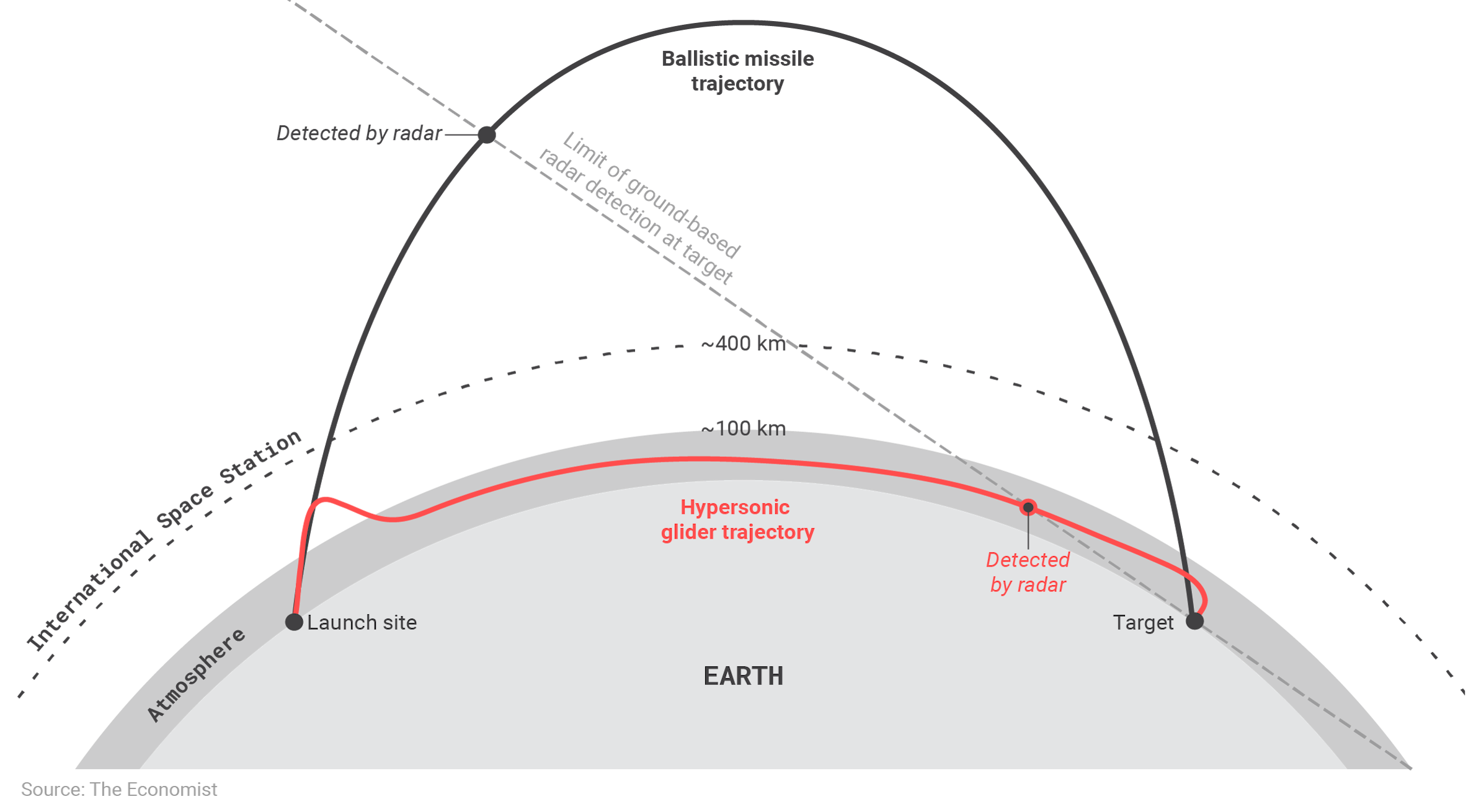
The Chinese are pursuing hypersonic technology, which could intensify a U.S.-China nuclear arms race.
That China is aggressively pursuing hypersonic technology and is likely ahead of the United States in this domain is not a surprise. Beijing paraded an operational hypersonic weapon, the DF-17 missile, with a notably innovative shape to its gliding warhead during the annual PLA military parade in 2019. Moreover, a 2018 Chinese source discussing the PLA’s hypersonic testing regimen concluded these technological breakthroughs would impact not only ICBM development, but also yield new weapons for both submarines and bombers, including both nuclear and “conventional warheads for sea attack.”57Che Fude [车福德], “An Important Leap for China’s Hypersonic Weaponry—The Significance of the Test Flight of the Xingkong II Glide Vehicle” [中国高超音速武器的重要跨越 — 星空二号乘波体飞行器试飞的意义], Modern Ships [现代舰船] (2018) no. 18: 24. According to this Chinese-language analysis, such weapons will enable ranges well beyond what was previously conceivable. That is to say that a warhead “‘riding’ the shock wave” can not only hit a vast domain of targets, but will also be “much harder to intercept.”58Che Fude [车福德], “An Important Leap for China’s Hypersonic Weaponry—The Significance of the Test Flight of the Xingkong II Glide Vehicle.”
Tactical nuclear weapons
While less novel than hypersonic weaponry, tactical nuclear weapons also represent a possible challenge for U.S.-China nuclear stability. The problem is not entirely new; the United States deployed the short-range Matador nuclear missiles to Taiwan in the 1950s to protect the island.
There is no direct evidence China is developing, let alone deploying, tactical nuclear weapons. However, the Chinese may react, or be reacting already, to the Trump administration’s decision that tactical nuclear weapons should re-enter the force. In early 2020, the USS Tennessee—an Ohio-class SSBN (the classification for a nuclear-powered, ballistic missile-carrying submarine)—was the first to go on patrol with missiles that carry the W76-2 low-yield tactical nuclear weapon. The yield of the W76-2 warhead is reported to be five kilotons. For comparison, the bomb that struck Hiroshima had a 19-kiloton yield, and the standard D-5 Trident II missile for American strategic submarines carries warheads with a yield of 90 kilotons (significantly more). This development has been emphasized in both of the detailed Chinese 2021 academic nuclear strategy analyses summarized above. PLA Daily also published an article in June 2019 that noted this weapon “will lower the nuclear threshold,” due in part to the lesser destructive yields and “also the lighter moral pressure.”59Lan Shunzheng [兰顺正], “Why Tactical Nuclear Weapons Are ‘Favored’ in the United States” [战术核武器缘何在美’受宠’], PLA Daily [解放军报], June 20, 2019, 11, http://www.81.cn/jfjbmap/content/2019-06/20/content_236472.htm.
Disturbingly, a 2019 Chinese naval analysis noted the limitations of conventional weapons for naval targeting and recommends tactical nuclear weapons, explaining “air burst nuclear weapons … are far less effective than underwater nuclear explosions” in terms of destructive value. Such weapons can not only be used to target both surface ships and submarines, but also “can assure damage even if the strike is not precisely on target …” and even destroy whole ship squadrons or groups with one blow.60Lyle Goldstein, “Keep the Cold War with China from Turning Hot,” National Interest, July 7, 2021, https://nationalinterest.org/feature/keeping-cold-war-china-turning-hot-65651. If indeed Beijing is exploring the possibility of deploying tactical nuclear weapons, this may parallel efforts on the strategic front to counter perceived U.S. superiority.
Recommendations for U.S. policymakers
1. U.S. nuclear force modernization should prioritize the sea leg of the triad
Nuclear weapons remain an essential component of U.S. defense. However, these forces have not seen adequate investment in recent decades, such that some platforms, including warhead components, are dangerously old. The United States is bound to possess the “ultimate weapon,” and it must be sure they are deployed safely and competently.61For a detailed report on a relatively recent incident, see Peter Grier, “Misplaced Nukes,” Air Force Magazine, June 26, 2017, https://www.airforcemag.com/article/misplacednukes/. As the sea leg of the triad remains the most survivable, it should be prioritized. In the age of drone warfare, the U.S. Navy should consider giving extra defenses to SSBN basing areas. Bombers face a much more uncertain future than do strategic submarines due to air base vulnerability, but their limited numbers should be maintained since they have dual-capable mission possibilities. Since ICBMs are the most vulnerable part of the triad, DoD should not prioritize building a new generation ICBM.
The policy of maintaining all three components of the triad and granting each part of the triad a nearly equal share of the resources should be broken, since it is an obsolete legacy of inter-service rivalry, strategically unsound, and overly expensive.62Benjamin Friedman, Christopher Preble, and Matt Fay, “The End of Overkill: Reassessing U.S. Nuclear Weapons Policy,” Cato Institute, September 24, 2013, https://www.cato.org/white-paper/end-overkill-reassessing-us-nuclear-weapons-policy. As demonstrated above, evidence suggests U.S. investments in both missile defense and tactical nuclear weapons are a driving force for Chinese (and Russian) nuclear weapons modernization programs.63This interpretation is supported by MIT Professor M. Taylor Fravel in a recent interview. See Interview with M. Taylor Fravel and Tong Zhao on “U.S.-China First Strike Showdown: Nuclear Tensions Rising” on the podcast of the National Committee for U.S.-China Relations, December 23, 2021, https://www.ncuscr.org/event/rising-nuclear-tensions/video. These efforts should be strictly limited in scope, so they do not themselves precipitate nuclear instability. The United States should act with confidence and restraint, rather than engaging in a “Sputnik moment” kind of panic that leads to heedless investment in unnecessary capabilities.64Benjamin Friedman, “Don’t Turn China’s Hypersonic Missile Test into a ‘Sputnik Moment,’” World Politics Review, October 28, 2021, https://www.worldpoliticsreview.com/articles/30077/don-t-turn-the-chinese-missile-test-into-a-sputnik-moment.
2. Elevate nuclear security dialogue with Beijing
The November 2021 agreement between President Biden and President Xi to undertake consultations on “strategic stability” is long overdue. U.S. and Chinese leaders and diplomats have often prioritized other issues, like trade and climate change, to the detriment of questions of nuclear stability. That is one reason so much uncertainty surrounds the current U.S.-China nuclear weapons relationship. When nuclear weapons have been discussed, it has nearly always been in the context of nuclear proliferation, whether concerning North Korea or Iran.
That the world’s two most powerful leaders should meet regularly is hardly a novel idea. Yet such a meeting occurred only once in 2021, whereas they were more frequent in the past. The “virtual” summit in November 2021 lasted three and a half hours, implying the heavily laden agenda, which is encouraging. For the benefit of Americans, and all citizens around the world, an annual in-person summit between U.S. and Chinese leaders that lasts for days should occur. One day, at least, of the annual summit should be devoted to nuclear stability and crisis mitigation. Naturally, these talks should be supported by a full raft of continuous engagements among experts, both within government and among non-governmental experts.
3. New arms control initiatives should be put on the table
It is often said serious U.S.-China nuclear arms control is out of reach, first and foremost, because of the asymmetric nature of the two arsenals. But it is also common in Washington to claim Beijing is not sufficiently trustworthy or that the relationship is too fraught to consider major defense agreements. The latter claims do not hold up to scrutiny.65See Timothy Webster, “Paper Compliance: How China Implements WTO Decisions,” Michigan Journal of International Law 35 (2014), No. 3, https://repository.law.umich.edu/cgi/viewcontent.cgi?article=1064&context=mjil. China entered the Comprehensive Test Ban Treaty (CTBT) in 1996 and has remained in compliance since. This is impressive given that the original CTBT was implemented jointly by the two Cold War superpowers in part to contain China’s nuclear program.66William Burr and Hector A. Montford, “The Making of the Test Ban Treaty, 1958–63,” The National Security Archive, August 8, 2003, https://nsarchive2.gwu.edu/NSAEBB/NSAEBB94/. Moreover, Beijing’s diplomats have demonstrated a responsible approach to nuclear crisis management, such as in the 2017–2018 North Korea nuclear crisis, wherein the Chinese proposal for “double freeze” helped ease tensions at a critical moment. China’s growing nuclear arsenal might make it more symmetrical in dimensions with the United States and Russia—thus allowing for more arms control solutions.
What are the most pressing and promising areas for developing proposals? A NFU policy was under active consideration in the winter 2021–2022 Biden administration Nuclear Posture Review, but proved to be a bridge too far from a political standpoint, even if it might have been modestly beneficial to U.S.-China nuclear stability.67Robert Einhorn, “No First Use Is Still a Bridge Too Far, But Biden Can Make Progress Toward that Goal,” Brookings Institution, October 2021, https://www.brookings.edu/wp-content/uploads/2021/10/FP_20211020nfu_einhorn.pdf. Indeed, it does seem that the Taiwan scenario, and possible U.S. first use in that scenario, is a driver of China’s current nuclear buildup, so the NFU, even one just for the United States and China, could potentially in the future help to mitigate that particularly sensitive aspect of the bilateral nuclear relationship. Urgent other new areas for arms control include artificial intelligence (AI) and tactical nuclear weapons.
The second issue is a fuse that could ignite a localized U.S.-China war into a global nuclear war. Hypersonic weaponry should be on the arms control agenda, but this will be especially difficult given the technologies are still in development. It might be most feasible to put a focus on both land-based systems (ICBMs and bombers) since all can agree that some of these systems are quite vulnerable and thus create first-strike incentives.
Concerning the most essential naval leg of the triad, Washington and Beijing should think outside the box and consider not only limitations on SSBN numbers, but also perhaps limits on anti-submarine warfare capabilities, and even possibly the designation of secure “bastion” zones. A SSBN “bastion” refers to the highly protected zones for strategic submarine operations, but such zones could be regulated, at least to some extent, affording great support to mutual deterrence and decreasing the chance of an undersea accident or inadvertent nuclear escalation. Playing undersea “cat and mouse”—whether in the South China Sea or off the Puget Sound—is not just expensive, but also conducive to U.S.-China nuclear instability.
With respect to all these proposals, Washington should be clear-eyed and realize Beijing is probably not yet in a place where it wants to negotiate these issues. Years of U.S.-China hostility created a pervasive pessimism regarding the bilateral relationship in both capitals. This could combine with China’s new confidence in its own military development prowess to prevent meaningful arms control. Beijing likely wants greater parity before it seriously considers nuclear arms control agreements.
4. Spheres of influence are the only reliable path to peace in a nuclear, multi-polar world
The condition of MAD, according to basic nuclear strategy theory, should be sufficient to assure peace between two nuclear powers. Evidence above suggests Chinese nuclear strategists understand this theory and its compelling logic. This condition likely came about in a definitive way with the deployment of the DF-31 road-mobile ICBM in the early 2000s, but the threshold may also have been crossed earlier. Yet this “fact” of MAD is under pressure due to U.S. accuracy gains, which make even conventional cruise missiles a part of a theoretical U.S. first strike.
One possible realistic agreement concerns a joint bilateral declaration on “mutual vulnerability” and further stating that “a nuclear war must never be fought.” Tong Zhao, senior fellow in Carnegie’s Nuclear Policy Program, called explicitly for such a step in late 2021.68Einhorn, “No First Use Is Still a Bridge Too Far, But Biden Can Make Progress Toward that Goal.” A similar proposal was reportedly considered by the Obama administration to enhance nuclear stability between the United States and China.69George Perkovich (Carnegie Endowment), presentation to the Princeton seminar on Science and Global Security, December 14, 2021. On this program, see https://sgs.princeton.edu/.
Alongside of arms control negotiations, a spheres-of-influence approach has the best promise to prevent a catastrophic war between China and the United States that could go nuclear. Realist thinkers, such as Hans Morgenthau or George Kennan, argued that spheres of influence were vital to keep the Cold War from turning into a hot war.70See, for example, Michael Kimmage and Matthew Rojansky, A Kennan for Our Time: Revisiting America’s Greatest 20th Century Diplomat for the 21st Century (Washington DC: Wilson Center, 2019), 197. Winston Churchill, famed for opposing appeasement in the late 1930s, was perfectly willing to practice spheres-of-influence diplomacy, for example with Joseph Stalin at Yalta, where they divided the Balkans into such spheres.
In the Cold War, this approach likely prevented wars, or at least crises, and the proxy wars that did break out tended to be on the margins between these two spheres, such as in Vietnam or, later, in Angola. In the contemporary U.S.-China strategic competition, strategists would be wise to resuscitate the concept of spheres of influence, wherein the other superpower will apply restraint and abjure military intervention. For example, due to the reasons discussed above, if China knew the United States would not intervene for Taiwan, or would not threaten to use nuclear weapons even if it did, it is quite possible its nuclear buildup would not have occurred. So even if U.S. policymakers are not prepared to reconsider the ambiguous extension of deterrence to Taiwan, they should understand a Chinese nuclear buildup and resistance to arms control is a likely price they will pay.
Great power politics and managing China’s nuclear expansion
In one of the 2021 Chinese academic nuclear strategy analyses evaluated above, Tsinghua scholar Hu Gaochen makes a salient point: “The U.S.-China relationship has not experienced a crisis as serious as the Cuban Missile Crisis.”71Hu Gaochen [胡高辰], “An Analysis of China-US Asymmetric Nuclear Stability and U.S. Strategic Opportunism” [中美不对称核稳定与美国战略机会主义论析], Chinese Foreign Policy [中国外交] (May 2021), 63. That is certainly a good thing. Yet he goes on to say in this context: “But … U.S.-China strategic rivalry becomes more obvious every day …”72Hu Gaochen [胡高辰], “An Analysis of China-US Asymmetric Nuclear Stability and U.S. Strategic Opportunism,” 63. Indeed, the Cuban Missile Crisis represents, by almost all scholarly accounts, humanity’s worst ever flirtation with the apocalypse. In the space of a few weeks in October 1962, a nuclear war could have started through inadvertent escalation, by accident, through incentives related to first strike, and the “use them or lose them” dilemma. Close calls occurred repeatedly.73See, for example, Svetlana V. Savranskaya, “New Sources on the Role of Soviet Submarines in the Cuban Missile Crisis,” Journal of Strategic Studies 28, No. 2 (April 2005): 233–259. It should not take another Cuban Missile Crisis to wake up American and Chinese decision-makers to the grave nuclear danger now stalking the ever more unstable U.S.-China strategic relationship. Moreover, current U.S.-Russian tensions over the Kremlin’s invasion of Ukraine seem to disturbingly illustrate that significant nuclear tensions can still haunt formerly stable deterrence relationships.
Nuclear stability should be front and center in the U.S.-China relationship. It is more important than either rare earths or cobalt mining. It is more important than unfair trading practices. And it is more important than North Korea, Iran, or Taiwan. Even climate change should yield before an issue that could decide the fate of the planet and most of its inhabitants in a mere 24 hours or less. Nuclear stability is infinitely more important than, and is undermined by, the “virtue signaling” that presently occupies a large part of the American discourse on China.
This paper demonstrates the rather significant Chinese buildup of nuclear weaponry now underway has often been misinterpreted in America, fueling irresponsible, unhelpful threat inflation. The unique Chinese-language sources evaluated in this study imply China is engaged in a steady buildup to ensure MAD not only exists in the U.S.-China nuclear relationship, but also that it is widely perceived to exist, including in Washington.
China’s nuclear buildup is likely intended as diligent preparation for a Taiwan scenario, perhaps in the coming decade, in a move designed to ensure nuclear stalemate and increase Washington’s hesitation to intervene in the event China invades Taiwan. That may appear as a change to the status quo and reaping the benefits of the nuclear buildup. Yet it is also the outcome of an overly aggressive and risky U.S. nuclear posture that has long overestimated the value of extended deterrence and underestimated the importance of spheres of influence for managing great power conflict.
While the United States should continue to monitor China’s nuclear modernization efforts and pursue its own prudent upgrades to U.S. nuclear forces, it is imperative to avoid a destabilizing overreaction to Chinese moves to narrow the gap in this area. That could fuel a spiraling new arms race or worse: a series of nuclear crises. The reality of the nuclear era is that caution and restraint, two fundamental principles of realism, remain essential.
Endnotes
- 1Idrees Ali and Phil Stewart, “Pentagon Sharply Raises Its Estimate of Chinese Nuclear Warheads,” Reuters, November 4, 2021, https://www.reuters.com/world/pentagon-sharply-raises-its-estimate-chinese-nuclear-warheads-2021-11-03/.
- 2Robert Burns, “Pentagon Rattled by Chinese Military Push on All Fronts,” Associated Press, November 1, 2021, https://apnews.com/article/technology-china-asia-united-states-beijing-aea288656fab23253ee0397dc21ba68a.
- 3Robert Jervis, The Meaning of the Nuclear Revolution: Statecraft and the Prospect for Armageddon (Ithaca, New York: Cornell University Press, 1990).
- 4Phil Stewart and Idrees Ali, “U.S. Delays ICBM Test-launch in Bid to De-escalate Russia Nuclear Tensions,” Reuters, March 2, 2022, https://www.reuters.com/world/us/us-delays-icbm-test-launch-bid-de-escalate-russia-nuclear-tensions-2022-03-02/.
- 5Fred Kaplan, “JFK’s First Strike Plan,” Atlantic, October 2008, https://www.theatlantic.com/magazine/archive/2001/10/jfks-first-strike-plan/376432/.
- 6Ankit Panda and Vipin Narang, “Sole Purpose is Not No First Use: Nuclear Weapons and Declaratory Policy,” War on the Rocks, Feb 21, 2021, https://warontherocks.com/2021/02/sole-purpose-is-not-no-first-use-nuclear-weapons-and-declaratory-policy/.
- 7Tara Copp, “Biden’s Nuke Review Omits ‘No First Use’, Kills Naval Cruise Missile,” Defense One, March 30, 2022, https://www.defenseone.com/policy/2022/03/bidens-nuke-review-omits-no-first-use-kills-naval-cruise-missile/363823/.
- 8Austin Long, “Deterrence from Cold War to Long War: Lessons from Six Decades of RAND Research,” RAND Corporation, 2008, https://www.rand.org/content/dam/rand/pubs/monographs/2008/RAND_MG636.pdf.
- 9Matt Korda and Hans Kristensen, “Nuclear Notebook: US Nuclear Forces in 2021,” Bulletin of the Atomic Scientists, January 12, 2021, https://thebulletin.org/premium/2021-01/nuclear-notebook-united-states-nuclear-weapons-2021/.
- 10Matt Korda and Hans Kristensen, “Nuclear Notebook: Chinese Nuclear Forces in 2021,” Bulletin of the Atomic Scientists, November 15, 2021, https://thebulletin.org/premium/2021-11/nuclear-notebook-chinese-nuclear-forces-2021/.
- 11Elbridge Colby, The Strategy of Denial: American Defense in an Age of Great Power Conflict (New Haven, CT: Yale University Press, 2021), 232.
- 12Colby, The Strategy of Denial: American Defense in an Age of Great Power Conflict, 232.
- 13Matt Korda and Hans Kristensen, “China is Building a Second Nuclear Missile Silo Field,” Federation of American Scientists, July 26, 2021, https://fas.org/blogs/security/2021/07/china-is-building-a-second-nuclear-missile-silo-field/.
- 14Matt Korda and Hans Kristensen, “China is Building a Second Nuclear Missile Silo Field.”
- 15Wang Ruichen, Li Jianlin, Liu Bingjie and Yang Haibo [王瑞臣,李建林,刘丙杰,杨海波], “Deployment and Development of USA Land-based Strategic Nuclear Force” [美国陆基战略核力量部署及发展], Ship Electronic Engineering [舰船电子工程] 41, no. 1: 3. It is worth noting the authors are identified as working at China’s Navy Submarine Academy in Qingdao. The Chinese assessment on the precision benefits of land-based systems may no longer be accurate when compared to American sea-based systems.
- 16Marcus Weiserber, “Air Force Secretary Warns of China’s Burgeoning Nuclear Arsenal, Reveals B-21 Detail,” Defense One, September 20, 2021, https://www.defenseone.com/threats/2021/09/air-force-secretary-warns-chinas-burgeoning-nuclear-arsenal-reveals-b-21-detail/185486/.
- 17Lyle Goldstein, “How Many Americans Would Die in a Nuclear War with China?” National Interest, October 21, 2021, https://nationalinterest.org/blog/reboot/how-many-americans-would-die-nuclear-war-china-194806.
- 18Lyle Goldstein, “How Many Americans Would Die in a Nuclear War with China?”
- 19Lyle Goldstein, “China Rattles the Nuclear Saber,” National Interest, February 22, 2017, https://nationalinterest.org/feature/china-rattles-the-nuclear-saber-19536.
- 20“Considering Rail Mobility Launch for the DF-41” [从东风-41看铁路机动发射], Ordnance Knowledge [兵器知识], May 10, 2016, http://bingqizhishi.1she.com/734/136506.html.
- 21See Qian Pu [钱普], “Tactics to Safeguard Submarine Egress” [保护潜艇出海战术动作], Naval and Merchant Ships [舰船知识] (Dec 1997): 32.
- 22Wu Riqiang [吴日强], “Have Chinese Strategic Nuclear Submarines Started Strategic Patrols?” [中国战略核潜艇开始战略巡航了吗?], Modern Ships [现代舰船] (2016) No. 1B: 32.
- 23Zhang Xuesong [张雪松], “The ‘Royalty’ of Submarine-launched Missiles: Looking Forward to the New Type of ‘Julang’ [SLBM] from China’s Breakthrough in Drag Reduction Rod Technology” [潜射导弹的’王冠’: 从中国突破减阻杆技術展望新型’巨浪’], Naval and Merchant Ships [舰船知识] (Jan 2020): 40; “Can Chinese Submarines Constitute a Reliable Nuclear Deterrent against the U.S.?” [中国核潜艇能对美国构成可靠和威慑吗?], Modern Ships [现代舰船] (2015), No. 10A: 39.
- 24Insert, PLA Pictorial [解放军画报], (March 2015), 8–9; Wu Yan and Chen Heying [武彦陈和莹], “China’s Air Force Flies Through the Miyako Strait for the First Time” [中国空军首次飞越宫古海峡], Global Times [环球时报], May 22, 2015, 8.
- 25He Min [赫敏], “Clear Blue Wins over Blue: Analysis of the H20 Bomber’s Research and Development Basis, the Basic Technical Design and Tactical Performance” [青出于蓝面而胜于蓝 浅析轰炸20轰炸机的研发基础, 基本设计技战术性能], Shipborne Weapons [舰载武器] (May 2020): 18.
- 26Zhang Jin and Zhang Jincun [张锦,张进存], “The Historical Background of Mao Zedong’s Thoughts on Nuclear Strategy” [毛泽东核战略思想的时代背景], Military History [军事历史] (March 2017), No. 216: 52.
- 27Zhang Jin and Zhang Jincun, “The Historical Background of Mao Zedong’s Thoughts on Nuclear Strategy,” 52.
- 28Zhang Jin and Zhang Jincun, “The Historical Background of Mao Zedong’s Thoughts on Nuclear Strategy,” 53.
- 29Philip Taubman, “U.S. and Peking Joining to Monitor Missiles in the Soviet,” New York Times, June 18, 1981, https://www.nytimes.com/1981/06/18/world/us-and-peking-join-in-tracking-missiles-in-soviet.html.
- 30John Lewis summarized in Baohui Zhang, China’s Assertive Nuclear Posture (London: Routledge, 2015): 14–15.
- 31Fiona S. Cunningham and M. Taylor Fravel, “Assuring Assured Retaliation: China’s Nuclear Posture and U.S.-China Strategic Stability,” Quarterly Journal: International Security, vol. 40. no. 2. (Fall 2015): 7–50.
- 32Kenneth N. Waltz, “Nuclear Myths and Political Realities,” American Political Science Review 84, no. 3 (1990): 731–45.
- 33Keir A. Lieber and Daryl G. Press, The Myth of the Nuclear Revolution: Power Politics in the Atomic Age (London: Cornell University Press, 2020), 36.
- 34Iain Johnston quoted in Lieber and Daryl G. Press, The Myth of the Nuclear Revolution: Power Politics in the Atomic Age, 17.
- 35Teng Jianqun (Director of the Arms Control and International Security Research Center of the China Academy of International Studies) in “How Many Nuclear Warheads Are Sufficient for China” [中国需要多少枚核弹才够], Global Times [环球时报], December 2014, http://news.sina.com.cn/pl/2014-12-18/072731298634.shtml.
- 36Li Bin, “Appendix 3A: China and Nuclear Transparency” SIPRI: 52, https://www.sipri.org/sites/default/files/files/books/SIPRI03Zarimpas/SIPRI03Zarimpas03A.pdf.
- 37Jiang Tianjiao [江天骄], “U.S. Warfighting Deterrence Nuclear Strategy: History, Theory, and Reality” [美国实战威慑核战略: 理论历史与现实], International Security Studies [国际安全研究] (2021), no. 2: 28–60. The author is a professor at Fudan University, one of China’s most prestigious universities.
- 38Jiang Tianjiao, “U.S. Warfighting Deterrence Nuclear Strategy: History, Theory, and Reality,” 51–53.
- 39Jiang Tianjiao, “U.S. Warfighting Deterrence Nuclear Strategy: History, Theory, and Reality,” 53.
- 40Jiang Tianjiao, “U.S. Warfighting Deterrence Nuclear Strategy: History, Theory, and Reality,” 28.
- 41Hu Gaochen [胡高辰], “An Analysis of China-U.S. Asymmetric Nuclear Stability and U.S. Strategic Opportunism” [中美不对称核稳定与美国战略机会主义论析], Chinese Foreign Policy [中国外交] (May 2021): 59–75. The author is a professor at Tsinghua University, one of China’s most prestigious universities.
- 42Hu Gaochen, “An Analysis of China-US Asymmetric Nuclear Stability and US Strategic Opportunism”: 59.
- 43Hu Gaochen, “An Analysis of China-US Asymmetric Nuclear Stability and US Strategic Opportunism”: 63.
- 44Hu Gaochen, “An Analysis of China-US Asymmetric Nuclear Stability and US Strategic Opportunism”: 64.
- 45Hu Gaochen, “An Analysis of China-US Asymmetric Nuclear Stability and US Strategic Opportunism”: 62.
- 46Hu Gaochen, “An Analysis of China-US Asymmetric Nuclear Stability and US Strategic Opportunism”: 71.
- 47Cui Yiliang [崔轶亮] “A Tactical Nuclear Exchange” [战术核交换] Modern Ships [现代舰船] (2021), no. 6: 15.
- 48Cui Yiliang, “A Tactical Nuclear Exchange”:15.
- 49Cui Yiliang, “A Tactical Nuclear Exchange”: 15.
- 50Cui Yiliang, “A Tactical Nuclear Exchange”: 15.
- 51Lieber and Press, The Myth of the Nuclear, 71.
- 52Lieber and Press, The Myth of the Nuclear, 80–83.
- 53Lieber and Press, The Myth of the Nuclear, 93. On the impact of Lieber and Press on Chinese thinking, see for example, Hu, “Analysis of China–U.S. Asymmetric Nuclear Stability,” 62.
- 54Colby, The Strategy of Denial, 175.
- 55Robert Farley, “The Real Risk Posed by China’s ‘Carrier Killer’ Missiles,” Business Insider, January 4, 2022, https://www.businessinsider.com/could-chinese-missiles-really-sink-a-us-navy-aircraft-carrier-2022-1.
- 56James Cameron, “What did China Test in Space, Exactly, and Why?,” Washington Post, October 21, 2021, https://www.washingtonpost.com/politics/2021/10/21/what-did-china-test-space-exactly-why/.
- 57Che Fude [车福德], “An Important Leap for China’s Hypersonic Weaponry—The Significance of the Test Flight of the Xingkong II Glide Vehicle” [中国高超音速武器的重要跨越 — 星空二号乘波体飞行器试飞的意义], Modern Ships [现代舰船] (2018) no. 18: 24.
- 58Che Fude [车福德], “An Important Leap for China’s Hypersonic Weaponry—The Significance of the Test Flight of the Xingkong II Glide Vehicle.”
- 59Lan Shunzheng [兰顺正], “Why Tactical Nuclear Weapons Are ‘Favored’ in the United States” [战术核武器缘何在美’受宠’], PLA Daily [解放军报], June 20, 2019, 11, http://www.81.cn/jfjbmap/content/2019-06/20/content_236472.htm.
- 60Lyle Goldstein, “Keep the Cold War with China from Turning Hot,” National Interest, July 7, 2021, https://nationalinterest.org/feature/keeping-cold-war-china-turning-hot-65651.
- 61For a detailed report on a relatively recent incident, see Peter Grier, “Misplaced Nukes,” Air Force Magazine, June 26, 2017, https://www.airforcemag.com/article/misplacednukes/.
- 62Benjamin Friedman, Christopher Preble, and Matt Fay, “The End of Overkill: Reassessing U.S. Nuclear Weapons Policy,” Cato Institute, September 24, 2013, https://www.cato.org/white-paper/end-overkill-reassessing-us-nuclear-weapons-policy.
- 63This interpretation is supported by MIT Professor M. Taylor Fravel in a recent interview. See Interview with M. Taylor Fravel and Tong Zhao on “U.S.-China First Strike Showdown: Nuclear Tensions Rising” on the podcast of the National Committee for U.S.-China Relations, December 23, 2021, https://www.ncuscr.org/event/rising-nuclear-tensions/video.
- 64Benjamin Friedman, “Don’t Turn China’s Hypersonic Missile Test into a ‘Sputnik Moment,’” World Politics Review, October 28, 2021, https://www.worldpoliticsreview.com/articles/30077/don-t-turn-the-chinese-missile-test-into-a-sputnik-moment.
- 65See Timothy Webster, “Paper Compliance: How China Implements WTO Decisions,” Michigan Journal of International Law 35 (2014), No. 3, https://repository.law.umich.edu/cgi/viewcontent.cgi?article=1064&context=mjil.
- 66William Burr and Hector A. Montford, “The Making of the Test Ban Treaty, 1958–63,” The National Security Archive, August 8, 2003, https://nsarchive2.gwu.edu/NSAEBB/NSAEBB94/.
- 67Robert Einhorn, “No First Use Is Still a Bridge Too Far, But Biden Can Make Progress Toward that Goal,” Brookings Institution, October 2021, https://www.brookings.edu/wp-content/uploads/2021/10/FP_20211020nfu_einhorn.pdf.
- 68Einhorn, “No First Use Is Still a Bridge Too Far, But Biden Can Make Progress Toward that Goal.”
- 69George Perkovich (Carnegie Endowment), presentation to the Princeton seminar on Science and Global Security, December 14, 2021. On this program, see https://sgs.princeton.edu/.
- 70See, for example, Michael Kimmage and Matthew Rojansky, A Kennan for Our Time: Revisiting America’s Greatest 20th Century Diplomat for the 21st Century (Washington DC: Wilson Center, 2019), 197.
- 71Hu Gaochen [胡高辰], “An Analysis of China-US Asymmetric Nuclear Stability and U.S. Strategic Opportunism” [中美不对称核稳定与美国战略机会主义论析], Chinese Foreign Policy [中国外交] (May 2021), 63.
- 72Hu Gaochen [胡高辰], “An Analysis of China-US Asymmetric Nuclear Stability and U.S. Strategic Opportunism,” 63.
- 73See, for example, Svetlana V. Savranskaya, “New Sources on the Role of Soviet Submarines in the Cuban Missile Crisis,” Journal of Strategic Studies 28, No. 2 (April 2005): 233–259.





